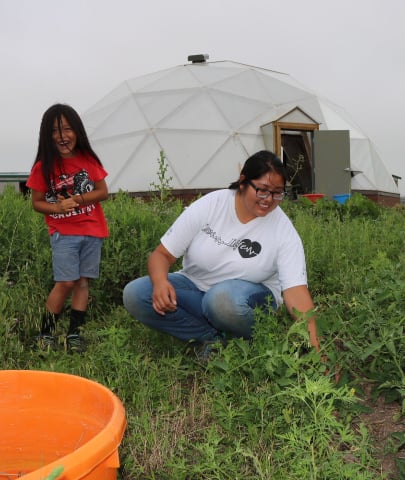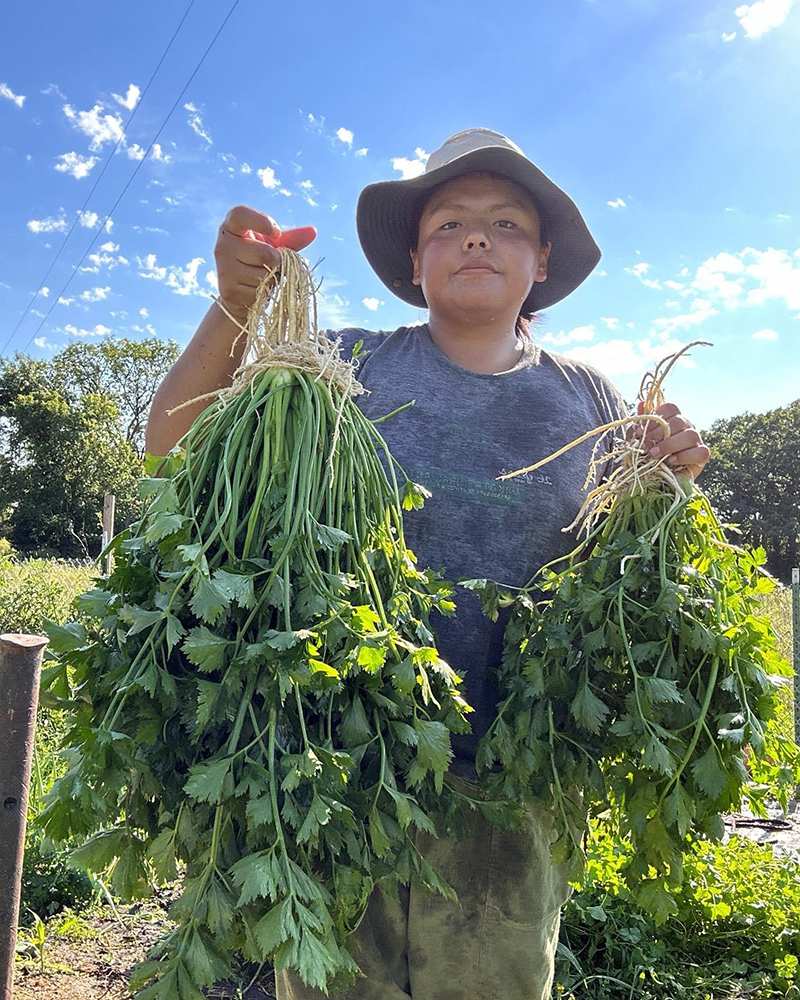Envisioning Indigenous Food Sovereignty as ‘a Whole Ecosystem’
In the summer of 2018, Matthew Wilson embarked on his first native-foods forage, a casual outing with friends on the Rosebud Reservation in rural southern South Dakota, where he grew up as a member of the Sicangu Lakota Oyate Nation. At 26 years old, he unearthed for the first time one of the prairie’s most prolific provisions: a wild turnip known as timpsila in the Lakota language.
“I picked up the root and peeled back the skin,” Wilson remembers. “Right there in the field, I took my first bite, and it was a powerful moment. Even though I had never tasted timpsila, its starchy sweetness was so familiar to me. It’s like my spirit instantly recognized it.” He speculates it was a surge of ancestral knowledge, downloading in one fateful moment; like many Indigenous peoples, the Sioux regard land stewardship as spiritual practice. Wotakuye is the Lakota belief that everything is interdependent and connected, and therefore, everything is kin.
Countless food discoveries later, Wilson is now the 30-year-old director of the Sicangu Food Sovereignty Initiative (FSI), which works to create a self-sustaining, ecologically sound and culturally appropriate food system for Rosebud. Established in 2015, the organization is run by the Sicangu Community Development Corporation (SCDC), a nonprofit that amplifies and preserves Lakota culture through food, language and health initiatives. Its larger mission is guided by an ancient Indigenous philosophy called the seventh generation principle: The “7Gen Plan,” in Sicangu shorthand, considers the welfare of people seven generations in the future, using the wisdom of seven generations in the past, adapted to the needs of the present day.
Indigenous foodways are not automatically inherited — cultural knowledge is often entangled in a complicated history of colonization that has resulted in a profound loss of land, language and culture. Many see food sovereignty as one way to reclaim that heritage. While the practice of food sovereignty is nothing new, the term was coined in 1996 by La Via Campesina, a global grassroots movement for agrarian reform, to affirm the right of people and nations to control their own food systems. Since then, the movement has taken hold around the U.S., from Navajo Nation to Inuit communities in Alaska, with a 2015 survey by the Indigenous Food and Agriculture Initiative indicating that most featured food sovereignty programs had been founded within the previous five years. Sicangu FSI programming, like many similar projects, is funded by grants from agencies of the Department of Agriculture, which also launched an Indigenous Food Sovereignty Initiative in 2021. Expanding those grants, as well as increasing access to other USDA initiatives, is a priority for the upcoming farm bill; these efforts are being led by the Native Farm Bill Coalition (NFBC), a broad assembly of tribes and advocacy organizations, including the Rosebud Sioux, which has been pushing lawmakers to do more for Native foodways since 2017.
Traditionally, hunting and gathering on the prairie were the main practices for the historically nomadic Lakota. But the controversial 1868 Treaty of Fort Laramie forced the Sioux — a confederation of Great Plains bands — to assimilate to an “American” standard that included mandatory flannel dress, English-speaking schools and sedentary farming on the newly established Great Sioux Reservation. In the 155 years since, this territory, originally 60 million acres, has been steadily subsumed by non-Native interests. “We’d like to see that land back,” said Rosebud Sioux Chief John Spotted Tail during a 2018 speech at the Smithsonian’s National Museum of the American Indian. “The United States does not honor this treaty and continues to break it, but as Lakota we honor it every day.”
The forcible erosion of Sioux culture has caused high rates of poverty, addiction and unemployment (on Rosebud, the current rate is around 83 percent). Nutrition and diet-related diseases are also a concern; today, Native communities have high rates of obesity and Type 2 diabetes. Wilson and his seven siblings grew up in a single-parent household where, as is the case with many reservation families, they stretched their benefits from the USDA’s Supplemental Nutrition Assistance Program (SNAP) by buying inexpensive commodity groceries. Last October, the Center on Budget and Policy Priorities reported that rural Native communities can pay as much as 71 percent more than the average U.S. consumer for fresh groceries like apples, milk and chicken, but actually pay cheaper prices for ultra-processed foods like Cheetos.
“The irony is that our ancestors foraged wild plants to survive,” Wilson says, “and now our ‘survival’ foods come out of a box or a can.” He recalls a time when he would specify frybread and Indian tacos as authentically Indigenous, even though their actual origins are in the U.S. Army rations (flour, sugar, dried beans, salt, coffee) provided for displaced Native Americans in the mid 19th century. Many of his neighbors did not grow up eating the Indigenous vegetation or the heritage dishes traditionally made from it, like wojapi, a stewed-fruit pudding made with late-summer chokecherries, or venison stew with timpsila.
“People will say, ‘That’s not how I was taught by my grandparents,’” Wilson says. “That attitude can really turn people off from learning this stuff.” Educating the community on heritage foodways is a large part of the FSI’s work, and is also enmeshed with Rosebud’s health initiatives: There is a collaborative food-medicine project, for instance, and organized prairie harvests are also billed as fitness walks.
In envisioning the Sicangu FSI, Wilson notes that the efforts of the Oneida Nation of Wisconsin were particularly inspiring — especially its manoomin (wild rice) harvesting program, which has helped restore tribal wetlands, and the 40-acre artificial lake constructed to revitalize traditional fishing practices. On the Oneida tribal lands outside of Green Bay, an award-winning farm to school program strives to serve students at least 80 percent community-grown food, much of which has been freshly harvested from the minimally tilled soil on the 7,000-acre Oneida Nation Farm.

Though the Lakota did have a historical practice of dispersing plant seeds along riverbanks to ensure a continuing food supply, agriculture was not central to their lifestyle. But the Sicangu FSI sees possibility in growing and producing food — a throughline across food sovereignty initiatives, according to a survey in the Journal of Agriculture, Food Systems, and Community Development that inventoried 123 programs around the western U.S. Adjacent to the Turtle Creek grocery store in the Rosebud town of Mission, FSI operates a 1-acre demonstration farm called the Keya Wakpala Garden. Its diminutive size belies its formidable contrast, philosophically speaking, to the dusty packaged foods next door and the large industrial agriculture presence on Rosebud. The bountiful beacon is a small part of the tribe’s 50,000 acres of farmland, the majority of which is leased to non-Indigenous industrial farmers and ranchers growing corn and wheat and raising cattle.
The parcel, which includes a geodesic greenhouse (a tropical testing ground for bananas and hibiscus), supplies a weekly CSA subscription service, two farmers’ markets and the lunch program at Wakanyeja Tokeyahci, the reservation’s Lakota language immersion school. It’s also a key feature in a future housing development, which broke ground in June 2023 and aims to have its first pod of five affordable, energy-efficient residences ready by the end of 2024. (Around 40 percent of on-reservation domiciles nationwide are considered “substandard,” meaning overcrowded, lacking heating or cooling or disconnected from sewer and phone lines.) Wilson hopes that REDCO — Rosebud Economic Development Corporation, which owns the grocery store — will transition it into a food co-op that abounds with produce from the growing number of Native farmers on the reservation. He says that as many as 50 small-scale farms have sprouted on Rosebud over the last five years.
During the pandemic, when supermarket shelves all around the reservation were sparsely stocked, there was a run on FSI’s free kits of seeds and starter plants as residents felt “an even greater sense of urgency for food sovereignty,” Wilson says. “People began to grow food to meet their own needs.” Interest in the Beginning Farmers Apprenticeship Program also ramped up during Covid, and the five newest participants have just completed their eight-month session, which ended in July. At Keya Wakpala, apprentices learn sustainable farming methods like cover cropping and crop rotation to rebuild the health of the compacted-clay soil, once choked with invasive Canada thistle (likely introduced by European colonists).
Soil health is also a concern for one of Rosebud’s newest projects, the 28,000-acre Wolakota Buffalo Range, established in 2020 on former cattle rangeland. When bison roamed the plains in thundering throngs tens of millions deep, Sioux ancestors shadowed their migration and hunted the animals conservatively for food, clothing and shelter. But 19th-century white settlers began killing them for fashion and sport until there were only about 300 left in the wild. Supported by the World Wildlife Fund (WWF), Wolakota now has 1,200 head of buffalo and counting, making it one of the largest Native-owned bison herds in the world. Thanks to this and other conservation efforts like those at the Oakland Zoo’s outbreeding program and the Department of the Interior’s Bison Working Group, the North American population is slowly rebounding. Today, the total population has surpassed 500,000.
“The return of bison can be very healing to grasslands,” explains Peter Bauman, a field specialist at South Dakota State University. A 2022 Ecological Monitoring study by the WWF proved that these sacred wooly bovines, a keystone species, have markedly improved the once-overgrazed soil on Wolakota since the project’s inception. As a living example of wotakuye, the range is already showing fewer invasive species, increased biodiversity and healthier grass. “There are native plants like Big Bluestem grass or the flowering leadplant that are still in the soil just waiting for the right conditions to be expressed,” Bauman notes.
Studies have also shown that grasslands are a considerable carbon sink, storing carbon more reliably than forests. Wolakota is an example of the intersection between Indigenous food systems, social justice and climate change, something Wilson discussed at the United Nations Climate Change Conference last November. “Many Native Americans who live on reservations are not financially able to move to a different location,” he explains. “So we have no choice but to live as land stewards.”
The Wolakota herd also ensures a reserve of high-quality meat for the community — without the threat of price-gouging, another pandemic repercussion of the industrial supply chain. FSI recently submitted a proposal to the USDA’s new Indigenous Animals Harvesting and Meat Processing Grant Program, hoping to secure funding for a meat-processing plant. (This expansion in USDA funding is among the priorities that the NFBC would like to see inked into the looming 2023 farm bill, along with tribe-administered SNAP benefits and the inclusion of traditional Indigenous foods in the Food Distribution Program on Indian Reservations.) As inspiration for its planned facility, FSI looked to the Osage Nation in Oklahoma, which built its own processing plant in 2021 using CARES Act funding to alleviate pandemic-era food insecurity.

Because many Rosebud households currently avoid local bison and game meat — a disconnect that “goes back to the disruption to our food system,” Wilson says — FSI programs include culinary education around native game. Wilson’s own repertoire includes “Chipotle-style” bison bowls (with wild rice) and an Indigenous take on chislic, South Dakota’s famous flash-fried meat cubes, that swaps antelope for more traditional lamb. Deanna EagleFeather, a former FSI farming apprentice, likes to make venison tamales and wild turkey pierogies. These dishes are a far cry from what the homesteader, who is half Sicangu Lakota, ate growing up in Minneapolis. “We lived across the street from a Burger King, if that tells you anything,” she says.
In 2015, EagleFeather, a tribal citizen, moved her family to Rosebud, where they are able to lease a 2.5-acre home site for $25 a year. With knowledge gained through working at FSI, volunteering with AmeriCorps and consuming numerous reference books and YouTube videos, EagleFeather’s homestead is now one of Rosebud’s most productive examples of food sovereignty. Surplus cherries, pears and apples from the orchard are destined for her homemade jams and jellies; extra ears of sweet corn are dried and ground into masa for tortillas and tamales. EagleFeather often pickles the vegetable garden’s bumper crop of tomatoes, onions, peppers and garlic, and is experimenting with lacto-fermentation. Soon, hogs and dairy goats will join the farm’s 13 resident hens.
EagleFeather, 31, doesn’t sell her produce or food products but rather stores them away to ensure her family of seven — she and husband Carlos Jarrett, a handyman, and their five kids, ages 10 years to 9 months — stay nourished and healthy on their rural outpost during the brutal South Dakota winters. For her part in advancing the 7Gen Plan, she hosts FSI apprentices and other community members at the homestead for canning workshops and interpretive walks on the farm and surrounding prairie.
“The most helpful thing I can do is show people how achievable food sovereignty is,” EagleFeather says. “It’s a whole ecosystem, which can feel pretty overwhelming. But for it to really take off on the reservation, the community needs to be involved. Because out here, community is all we have.”
Get the latest food news, from FoodPrint.
By subscribing to communications from FoodPrint, you are agreeing to receive emails from us. We promise not to email you too often or sell your information.
Top photo: Bison on the Wolak̇ota Regenerative Buffalo Range. (credit: ©Tailyr Irvine-WWF-US)
More Reading
Restoring Native foodways requires returning land. What happens when it's contaminated?
June 10, 2025
Big Banana’s bitter labor truths
May 13, 2025
The racist roots of Black land loss
February 25, 2025
Why worker welfare is critical to truly “sustainable” wine production
January 10, 2025
How we came to rely on emergency food
September 30, 2024
Food and farmworkers need protection from heat and other dangers
August 28, 2024
How can ecofeminism help us envision the future of food?
July 18, 2024
A new agritourism network connects and promotes farmers of color
June 11, 2024
After season 2 of ‘High on the Hog,’ there is more to be told
March 19, 2024
The 'unseen hands' of the food system
February 27, 2024


